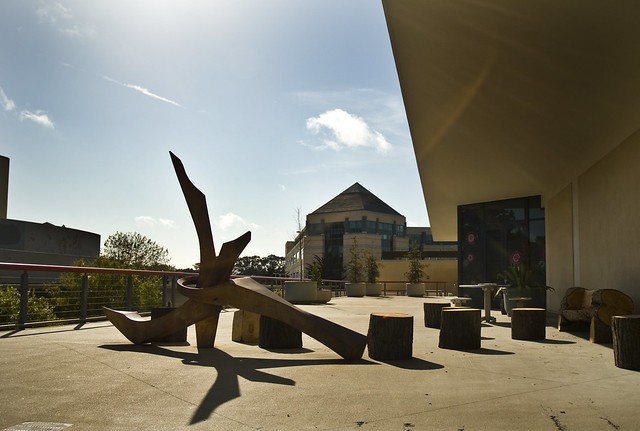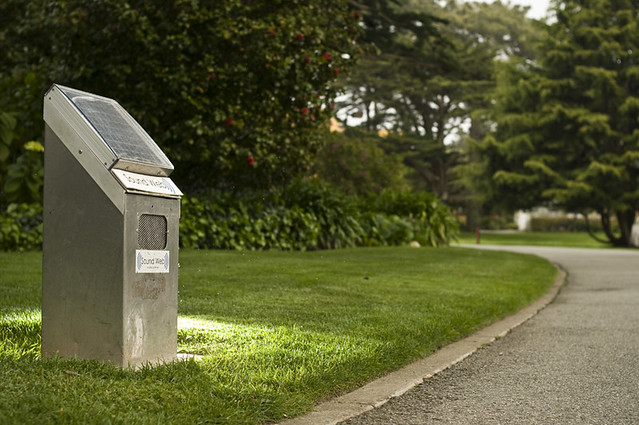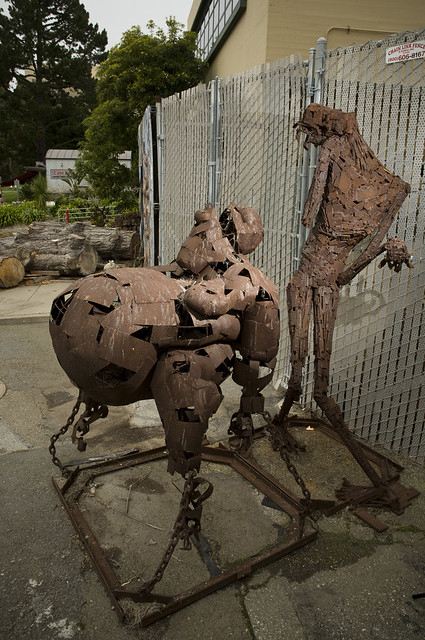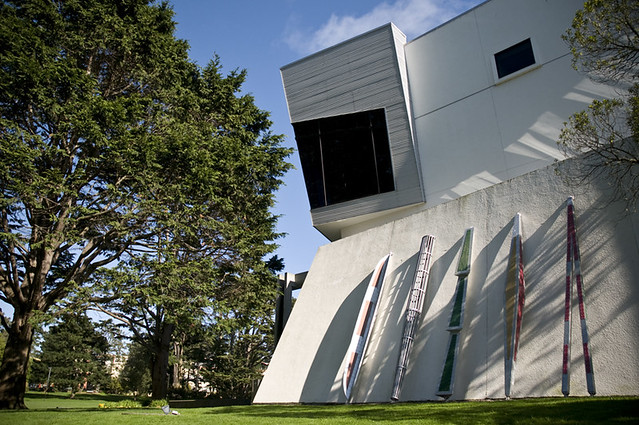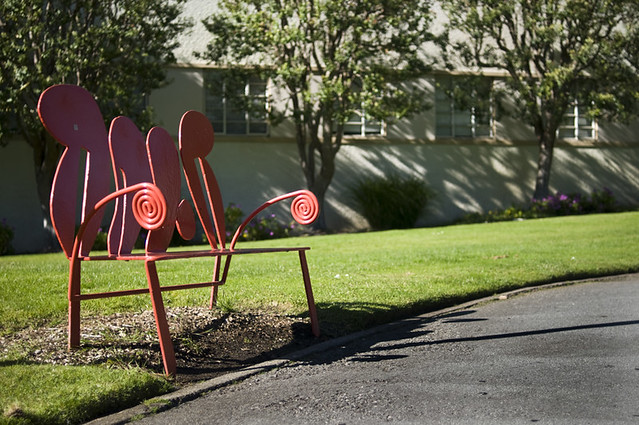To the untrained or inattentive observer, the campus of San Francisco State University is just that: a campus. The concrete and stucco of the Cold War era buildings are offset by the almost artificial brilliance of the lawns, reflected by the tinted glass that dominates the school’s new structures.
But in this dull monotony of a run-of-the-mill public university campus hides a whole variety of things worth discovering. SF State was, after all, founded in 1899, and over the last 112 years, students, teachers, staff, and artists have all done their part to make the campus into something more than the sum of its parts.
Sound Web
What is it?
Sound Web is made up of 10 different “audible features.” Each of these features is, in fact, a small, brushed aluminum enclosure with a solar panel and a speaker, standing no more than two feet off the ground. Each enclosure plays one of four different sounds: Wind-Chime, Percussion and Rhythm, Bird-Call, or Cricket Chips. Scattered around campus, the sounds are meant to provide a guide to the visually impaired. The components are designed by SF State’s engineering students and professors, and are built as simply as possible—a good thing, since they have been repeatedly vandalized.
Why you should care:
A cool idea, and the sounds definitely add something to the ambiance of the campus, but trying to navigate around campus using only the different sounds? Way too hard, at least for this not-blind reporter.
The Idiot
What is it?
The dilapidated, rusty features that make this metal sculpture so uncomfortable to look at also make it hard to miss. This eerie humanoid metal sculpture by artist R. Stone is located just behind the fine arts building across the road from the Humanities building. Several other works in the same style compliment the weathered metal art piece.
Why you should care:
These sculptures may make you feel uncomfortable, but that doesn’t make them any less works of art. The fabrication and patience required to create a form out of scrap metal and chain are impressive alone, even if the end result might not be for everybody.
Roots of Freedom/Raices De Libertad
What is it?
This mural is the first of three stunning works of Chicano-inspired art that grace the lowest level of the Cesar Chavez Student Center. The first mural visible after coming down the stairs, the Roots of Freedom was completed in 1990, helped by sponsorship by the League of Chicano Artists/Taller de Arte Publico.
Why you should care:
Not the most stunning of the three works of art in the Cesar Chavez basement, but it depicts the most powerful political message, complete with activists being kept behind bars.
Cross of Quetzalcoatl
What is it?
The second of the three large works in the Cesar Chavez Student Center, the Cross of Quetzalcoatl was completed in 1991 by the Precita Eyes muralists, which describe themselves as “an inner city, community-based mural arts organization.” While the organization is based in the Mission, they have collaborated on projects not only around San Francisco, but as far away as Brazil, Russia, and Germany as well.
Why you should care:
Quetzalcoatl is an Aztec deity believed to be a half-bird, half-snake deity, although his name was also taken on by many Aztec leaders, making it difficult to separate the deity’s actions from those of the rulers. As far as the piece of art goes, it has a very traditional look to it, which works nicely to balance out the constant noises of the arcade games that dominate the room.
Rise/Libertad
What is it?
This enormous mural dominates the bottom floor of the Student Center. Juana Alicia, who describes herself as “a muralist, print-maker, educator, activist, and painter who loves to draw,” painted the mural in 1990.
Why you should care:
With its bright colors, multiple layers and a hint of graffiti-style, Rise is easily the most eye-grabbing of the three big murals on Cesar Chavez Student Center’s recreation level. This painting manages to keep enough of the traditional Chicano feel to match the other two works, but is also more contemporary, thanks to its use of neon colors and a more modern style.
Universal Design Seating Studio
What is it?
This is actually a threesome of innovative approaches to seating, located on the patio of the Fine Arts building. A joint project between SF State design and industry and engineering students, Facilities Management and the Disability Programs and Research Center, the project tries to create novel ways to solve the issue of seating. MyTable is an adjustable-height table that features a wheel in the middle to rotate the whole assembly, and surrounding benches for seating. The now-defucnt MySolarTable is much the same, but used a solar panel to power an electrical lift to adjust the table height. Finally, The OpenBench is a series of recycled-plastic benches around a planter. The benches slide back and forth and tracks to create a number of different seating arrangements.
Why you should care:
All of the Universal Design Seating Studio is showing its age, but we were most bummed out that MySolarTable seems to be completely inoperable, and to make matters worse, it is stuck at a less-than-comfortable height. It would be great to see someone get the rig working again. Our favorite, and the most practical, is the OpenBench, which still works flawlessly and is very adaptable.
Untitled Works
What are they?
While sitting at the Universal Design Seating Studio, be sure to check out these modern art metal sculptures by Manuel Martin on the same Fine Arts building patio. Also, be sure to check out the wooden benches carved out of enormous logs while you are up there.
Why you should care:
The rusty surface of these steel structures falls somewhere in between “cool, old and weathered” and simply “derelict.” It may seem odd to have large hunks of steel on an second-story patio, but it is the fine arts building.
Rigoberta Menchu Hall
What is it?
This makes our list because it is the coolest place to chill out or study at SF State. Located on the Terrace level (the top floor) of the Cesar Chavez Student Center, the multi-level lounge/study area feels more like a home than a school, complete with couches and large areas that seem to be meant for fires. The hall’s namesake, Mecnhu won a Nobel Peace Prize in 1992 for her work to publicize the plight of the indigenous peoples of Guatemala during that nation’s civil war from 1960 to 1996.
Why you should care:
A great place to study, but it fills up fast. Try checking the topmost levels for free seating, but the best bet is to get there early, or go during off-hours when campus is less busy.
SF State Observatory
What is it?
Located at the top of Thornton Hall, the Observatory is open to the public Monday and Wednesday evenings from 8 to 9:30 p.m., weather permitting. The observatory promises views of the Orion Nebula, the Pleiades, and the Andromeda Galaxy, just to name a few.
Our verdict
Seriously awesome. If you even have a remote interest in stars, the sky, or astronomy, check it out.
Flaura
What is it?
On the path leading to the Humanities building across from Cafe Rosso, Kevin La created this metal art enclosure for an electric utility box as a student work. Different size metal circles are cut out and welded together on a metal frame, creating a beautiful floral pattern that encapsulates and hides the utilitarian box that lurks beneath.
Why you should care:
The whole is definitely more than the sum of its parts in this case. It’s amazing what even a little, simple art can do to spruce up something like an ugly utility box. The world needs more art like this.
The Garden of Remembrance
What is it?
Located on the path between Burk Hall and Cesar Chavez, the Garden of Remembrance was created to honor the 19 Japanese American SF State students who were forced into internment camps during World War II. The 2001 build was led by Japanese American artist and internment camp victim Ruth Asawa, and features a waterfall and ten large boulders from each of the ten internment camps.
Why you should care:
A surprisingly touching story behind what many probably just see as a fountain and rock garden in a courtyard. But however you choose to see it, the flowing water has a nice calming effect to help balance out the madness of college.
Ode to Hank
What is it?
These five aluminum totems that lean against the Cesar Chavez Student Center across from the gym are, in fact, a tribute by artist Terry Marashlian to the original installation of five wooden totem poles by artist Hank De Rlcco. “I meant them to be way more architectural,” Marashlian told [X]press in 2008.
Why you should care:
A brilliantly modern take on the idea of a totem pole. Aluminum construction and high tech finishing ala yachting and automotive design bring the icons of the Pacific Northwest into the 21st century.
Buckeye and Benches
What is it?
Outside the gym, this enormous, modern-art metal sculpture by William Wareham would be impressive enough standing on its own, but it is also complimented by three matching benches that are scattered around the area.
Why you should care:
The sculpture we can take or leave, but we love the benches. Whenever art meets practicality, everybody wins. The bright reds, oranges and yellows that color this piece make it stand out from the bright green lawn and the grayed gym building that make up the background.


